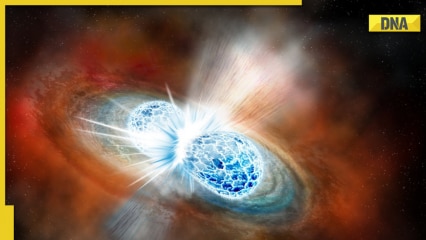What is Kilonova emission? Know how the rare astronomical event was detected

While tracing a burst of high-energy light identified in 2021, astronomers discovered the first astronomical event in which a long gamma-ray explosion (GRBs) and a rare kilonova emission coexisted.
This occurred about 1 billion light-years away, on the edges of the Milky Way.
The earliest stage of a kilonova was observed by the 3.6 m Devasthal Optical Telescope (DOT). Its crucial information fundamentally altered scientists’ view of the origin of GRBs.
GRBs are extremely strong cosmic bursts of high-energy gamma rays that produce more energy in a few seconds than our Sun will produce in its entire lifetime.
It emits in two separate phases:
- Rapid emission that lasts only briefly (the initial burst phase that emits gamma rays).
- A multi-wavelength afterglow phase with a long lifetime.
Space-based gamma-ray missions immediately identify the initial gamma-ray emission or prompt emission of GRBs. Among them are India’s AstroSat, the Neil Gehrels Swift Observatory, and the NASA Fermi Gamma-ray Space Telescope.
What is Kilonova?
The radiations that are released when two neutron stars or any other binary system merge are known as kilonova emissions. They may also be related to brief GRBs and can be seen as infrared light when short-period GRBs are present. It is also recognised as a gravitational wave source that might exist.
According to a theory, heat generated by the radioactive decay of heavier atoms could release kilonova. The production of heavier elements like gold and platinum is also possible using this technique. The 3.6-m DOT of the Aryabhatta Research Institute of Observational Sciences (ARIES) is one of the few telescopes on Earth that is capable of detecting kilonova and gravitational wave objects at these wavelengths up to faint limitations because of the laborious nature of the task.
Why did they notice it?
The high-energy outburst from the oGRB (GRB 211211A), which was discovered by NASA’s Neil Gehrels Swift Observatory and the Fermi Gamma-ray Space Telescope on December 11, 2021, lasted for about a minute, according to data from the 3.6 m DOT of the ARIES and data from other telescopes, including the Hubble Space Telescope.
A kilonova was discovered through additional observations made with the 3.6-meter Devasthal Optical Telescope.
Both thermal and non-thermal emissions were present in the afterglow’s spectrum energy distribution in this instance, based on observations made by the 3.6 m DOT.
Stay connected with us on social media platform for instant update click here to join our Twitter, & Facebook We are now on Telegram. Click here to join our channel (@TechiUpdate) and stay updated with the latest Technology headlines. For all the latest Technology News Click Here
